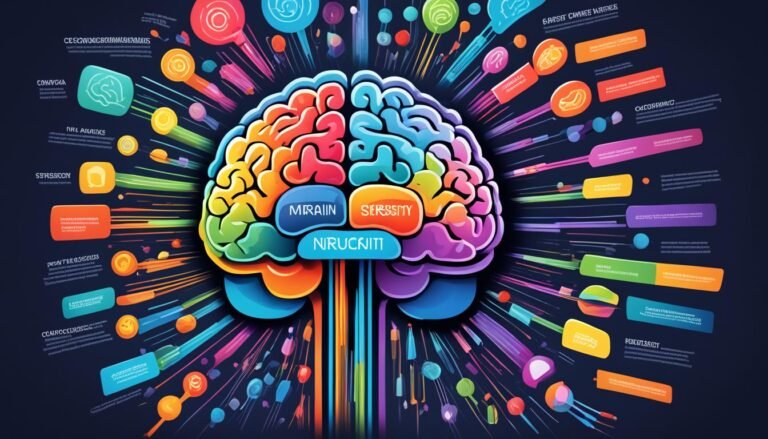Target Audience Psychological Profiling
They say that knowledge is power. In the world of marketing, this couldn't be truer. Understanding your target audience on a deeper level allows you to craft strategies that resonate with their desires and motivations, ultimately leading to increased conversion rates and brand loyalty.
But how exactly can you tap into the minds of your customers? How can you uncover their psychological traits and leverage that knowledge to gain a competitive advantage? In this discussion, we will explore the fascinating world of target audience psychological profiling and delve into the ethical considerations that come with it.
Get ready to unlock the secrets behind consumer behavior and discover how you can tailor your content to engage your audiences like never before.
Key Takeaways
- Understanding consumer behavior is essential for businesses to effectively target their audience and drive successful marketing strategies.
- Analyzing personality traits provides insights into consumers' preferences, motivations, and decision-making processes, allowing marketers to tailor their efforts to specific personality types.
- Uncovering hidden motivations and understanding subconscious desires allows marketers to create more targeted and persuasive campaigns.
- Developing effective marketing strategies starts with a thorough target audience analysis, including segmentation based on demographics, psychographics, and behavior.
Understanding Consumer Behavior
Understanding consumer behavior is crucial for businesses to effectively target their audience and drive successful marketing strategies. Consumer decision making and the subconscious influences that shape it play a significant role in this process. By gaining insights into the factors that influence consumer behavior, businesses can tailor their marketing efforts to better resonate with their target audience.
Consumer decision making is a complex process that involves various stages, including problem recognition, information search, evaluation of alternatives, purchase decision, and post-purchase evaluation. Throughout these stages, consumers are influenced by both conscious and subconscious factors. While conscious factors include rational considerations such as price, quality, and brand reputation, subconscious influences have a powerful impact on consumer behavior.
Subconscious influences can be categorized into two main types: internal and external. Internal influences stem from personal characteristics, beliefs, attitudes, and motivations, while external influences arise from social, cultural, and environmental factors. Examples of internal influences include personality traits and personal values, while external influences can include social norms and peer pressure.
Understanding these subconscious influences is essential for businesses to create effective marketing strategies. By leveraging psychological insights and data-driven research, businesses can better understand their target audience's decision-making processes. This knowledge can then be used to develop strategies that appeal to consumers' subconscious desires, resulting in more successful marketing campaigns.
Analyzing Psychological Traits
Analyzing psychological traits is a vital aspect of understanding consumer behavior and developing targeted marketing strategies. By examining personality traits, marketers can gain valuable insights into consumers' preferences, motivations, and decision-making processes. This information enables them to predict consumer behavior and tailor their marketing efforts accordingly.
To illustrate the significance of analyzing personality traits, consider the following table:
| Personality Trait | Consumer Behavior |
|---|---|
| Extraversion | Likely to seek social interaction and enjoy group activities. |
| Conscientiousness | More likely to make informed decisions and prefer structured experiences. |
| Openness to Experience | More receptive to new ideas and willing to try innovative products. |
| Neuroticism | More prone to anxiety and may respond strongly to emotional appeals. |
Analyzing these traits allows marketers to segment their target audience and design marketing strategies that resonate with specific personality types. For example, an extraverted consumer may respond well to campaigns that emphasize socializing and shared experiences, while a conscientious consumer may appreciate messages that highlight the reliability and quality of a product.
Uncovering Motivations and Desires
To gain a comprehensive understanding of consumer behavior and effectively tailor marketing strategies, it's essential to delve into the underlying motivations and desires that drive individuals' purchasing decisions. Uncovering hidden motivations and understanding subconscious desires allows marketers to create more targeted and persuasive campaigns.
By analyzing consumer data and conducting market research, marketers can gain valuable insights into what drives their target audience to make specific purchasing choices.
Here are five key factors that contribute to uncovering motivations and desires:
- Psychological needs: Understanding the fundamental needs that individuals are seeking to fulfill through their purchases.
- Emotional triggers: Identifying the emotions that influence buying decisions, such as the desire for status, belonging, or self-expression.
- Unconscious biases: Recognizing the unconscious biases and beliefs that shape consumer preferences and decision-making.
- Social influence: Examining the role of social influence in shaping consumer behavior, such as the impact of peer recommendations or societal trends.
- Personal values: Recognizing the values that guide individuals' choices and aligning marketing messages with those values.
Developing Effective Marketing Strategies
To develop effective marketing strategies, you need to start with a thorough target audience analysis.
By understanding your consumers' behavior, preferences, and needs, you can tailor your marketing messages and tactics to better resonate with them.
This will ultimately help in influencing their purchase decisions and driving them towards your products or services.
Target Audience Analysis
Effective marketing strategies are developed through a comprehensive understanding of the target audience's psychological profiling. Target audience analysis involves the segmentation of consumers based on various factors such as demographics, psychographics, and behavior. By understanding the different segments within the target audience, marketers can tailor their strategies to meet the specific needs and preferences of each group.
This analysis also involves studying consumer decision-making processes to identify the factors that influence their purchasing behavior. Here are five key elements to consider in target audience analysis:
- Demographic information: Age, gender, income, and education level.
- Psychographic characteristics: Values, lifestyle, attitudes, and interests.
- Behavioral patterns: Buying habits, product usage, and brand loyalty.
- Motivations and needs: What drives the target audience to make purchasing decisions.
- Cultural factors: Beliefs, customs, and traditions that influence consumer behavior.
Consumer Behavior Understanding
By understanding consumer behavior, marketers can develop effective marketing strategies tailored to meet the specific needs and preferences of their target audience. Consumer behavior analysis and market segmentation are key components in this process. Analyzing consumer behavior helps identify patterns, preferences, and motivations that drive purchasing decisions. Market segmentation further allows marketers to group consumers based on shared characteristics, such as demographics, psychographics, or buying behaviors. This segmentation enables marketers to create targeted marketing campaigns that resonate with specific consumer groups.
| Consumer Behavior Analysis | Market Segmentation |
|---|---|
| Identify patterns, preferences, and motivations | Group consumers based on shared characteristics |
| Understand purchasing decisions | Demographics, psychographics, buying behaviors |
| Tailor marketing strategies | Create targeted campaigns |
Influencing Purchase Decisions
Understanding consumer behavior and market segmentation lays the foundation for developing effective marketing strategies that influence purchase decisions. To effectively influence consumers' purchase decisions, marketers employ various influence techniques and persuasive messaging strategies.
Here are five key techniques to consider:
- Social proof: Utilize testimonials, reviews, and endorsements to show that others have already made the desired purchase and are satisfied.
- Scarcity: Highlight limited availability or time-sensitive offers to create a sense of urgency and encourage immediate action.
- Authority: Position your brand or product as an expert or authoritative figure in the industry to enhance credibility and trustworthiness.
- Emotional appeal: Create an emotional connection with consumers by focusing on their desires and aspirations, appealing to their values and beliefs.
- Personalization: Tailor your messaging to individual consumers, using data and insights to provide personalized recommendations and offers.
Tailoring Content to Engage Audiences
To effectively engage your target audience, it's crucial to understand their preferences and interests. By analyzing data on their behavior and demographics, you can tailor your content to align with their specific needs and desires.
Additionally, creating an emotional connection through storytelling can further captivate and resonate with your audience, fostering a deeper level of engagement.
Audience Preferences and Interests
Tailoring content to engage audiences involves analyzing and catering to their specific preferences and interests. By understanding audience segmentation and consumer psychology, marketers can create content that resonates with their target audience.
Here are five key factors to consider when tailoring content:
- Demographics: Age, gender, location, and socioeconomic status all impact audience preferences and interests. For example, younger audiences may be more interested in trends and technology, while older audiences may prefer more traditional content.
- Psychographics: Understanding the values, beliefs, and attitudes of your audience allows you to align your content with their interests. Whether they value sustainability, adventure, or personal growth, tailoring content to match these preferences can increase engagement.
- Cultural factors: Cultural background, traditions, and customs shape audience preferences. Adapting content to reflect diverse cultures can help connect with a broader range of audiences.
- Personalization: Tailoring content to individual preferences through personalized recommendations or targeted advertising can significantly enhance audience engagement.
- Trend analysis: Staying up to date with the latest trends and interests within your target audience's niche ensures your content remains relevant and appealing.
Emotional Connection and Storytelling
Creating an emotional connection through storytelling is a powerful strategy for engaging audiences with tailored content.
Emotional storytelling allows brands to build empathy with their target audience, connecting on a deeper level and fostering a stronger relationship.
Research has shown that emotional content is more likely to be remembered and shared, making it an effective tool for marketers.
By tapping into the emotions of their audience, brands can create a memorable and impactful experience that resonates with consumers.
Building empathy through storytelling involves understanding the needs, desires, and challenges of the target audience and crafting narratives that address these issues.
This approach helps brands establish a genuine connection and establish themselves as trusted allies, ultimately leading to increased engagement and loyalty.
Enhancing Customer Experience
By analyzing customer behavior and preferences, businesses can optimize their processes to create a more personalized and efficient experience for their target audience. This not only leads to increased customer satisfaction but also helps in building long-term relationships with customers.
Here are some key techniques that businesses can use to enhance the customer experience:
- Tailored Recommendations: By using data analytics and artificial intelligence, businesses can provide personalized product recommendations based on a customer's past purchases and browsing history. This helps customers find products that align with their preferences, saving them time and effort.
- Seamless Omnichannel Experience: Customers today expect a seamless experience across various touchpoints, whether it's online, in-store, or through mobile apps. By integrating these channels and ensuring consistency in messaging and branding, businesses can provide a more convenient and cohesive experience.
- Efficient Customer Support: Businesses can leverage technology like chatbots and self-service portals to provide quick and efficient customer support. This reduces wait times and allows customers to find solutions to their queries or issues on their own.
- Streamlined Checkout Process: Simplifying the checkout process by offering multiple payment options, saving customer information for future purchases, and minimizing the number of steps involved can significantly improve the customer experience.
- Feedback and Measurement: Regularly collecting customer feedback and measuring customer satisfaction through surveys and metrics like Net Promoter Score (NPS) helps businesses understand areas for improvement and make data-driven decisions to enhance the customer experience.
Increasing Conversion Rates
To further optimize the customer experience and drive business growth, understanding how to increase conversion rates is essential. Increasing website traffic and optimizing landing pages are key strategies to achieve this goal.
One effective way to increase website traffic is through targeted advertising. By identifying your target audience and tailoring your ads to their specific interests and needs, you can attract more qualified visitors to your site. Additionally, optimizing your website for search engines can improve your organic traffic. Conduct keyword research to understand what your audience is searching for and incorporate those keywords into your website content.
Once you have increased your website traffic, it's important to focus on optimizing your landing pages. A well-designed landing page can significantly increase your conversion rates. Start by ensuring that your landing page is visually appealing and easy to navigate. Use clear and concise messaging to convey the value of your product or service. Include compelling call-to-action buttons that are prominently displayed on the page.
Furthermore, conducting A/B testing can help you identify which elements on your landing pages are most effective in driving conversions. Test different headlines, layouts, colors, and call-to-action buttons to determine what resonates best with your audience.
Improving Brand Loyalty
Improving brand loyalty can be achieved through consistent delivery of exceptional customer experiences. When customers are satisfied with their interactions with a brand, they're more likely to remain loyal and continue supporting the brand in the long run.
Here are five key strategies to enhance brand loyalty and customer satisfaction:
- Personalization: Tailor your products, services, and communication to meet the individual needs and preferences of your customers. This shows that you value and understand them, fostering a deeper connection.
- Consistency: Maintain a consistent brand image, messaging, and quality across all touchpoints. This creates a sense of reliability and trust, which are vital for building long-term relationships.
- Timely and responsive customer service: Provide prompt and efficient customer support to address any issues or concerns. Responding quickly to customer inquiries and resolving problems demonstrates your commitment to their satisfaction.
- Loyalty programs: Implement loyalty programs that reward customers for their continued support. Offering exclusive discounts, freebies, or special perks can incentivize repeat purchases and strengthen brand loyalty.
- Solicit feedback and act on it: Regularly seek feedback from customers, whether through surveys, reviews, or social media engagement. Actively listen to their suggestions and concerns, and make improvements based on their feedback. This shows that you value their opinions and are committed to delivering a better customer experience.
Ethical Considerations in Psychological Profiling
When considering the ethical implications of psychological profiling, it is important to examine how the practice of profiling intersects with privacy rights and potential biases. Ethical considerations in psychological profiling revolve around the need to balance the benefits of profiling with the potential harm it may cause to individuals and society as a whole.
One major ethical concern is the invasion of privacy. Psychological profiling often involves collecting and analyzing personal information about individuals, such as their online activities, purchasing habits, and social media interactions. This raises questions about the extent to which individuals' privacy is being violated and whether they have given their informed consent for their data to be used in this way.
Another ethical consideration is the potential for bias in psychological profiling. Profiling techniques rely on algorithms and machine learning algorithms to analyze data and make predictions about individuals' behaviors and preferences. However, these algorithms can perpetuate biases that exist in the data they are trained on, leading to unfair and discriminatory profiling practices.
To illustrate the ethical considerations in psychological profiling, the following table presents a comparison of the benefits and potential risks associated with this practice:
| Ethical Considerations | Benefits | Potential Risks |
|---|---|---|
| Privacy concerns | Personalized marketing | Invasion of privacy |
| Enhanced customer experience | Unauthorized data collection | |
| Improved product development | Data breaches | |
| Misuse of personal data | ||
| Potential biases | Targeted advertising | Discrimination |
| Efficient resource allocation | Unfair profiling practices | |
| Increased revenue | Exacerbation of social issues |
Leveraging Data for Competitive Advantage
Leveraging data analytics provides companies with a strategic advantage in today's competitive market. By harnessing the power of data, companies can gain valuable insights and make informed decisions to stay ahead of the competition. Here are five ways in which businesses can leverage data analytics for competitive advantage:
- Identifying customer preferences: By analyzing customer data, companies can gain a deep understanding of their preferences, behaviors, and needs. This information can be used to tailor products and services to meet customer demands, increasing customer satisfaction and loyalty.
- Optimizing pricing strategies: Data analytics can help companies understand how customers respond to different pricing strategies. By analyzing pricing data and market trends, businesses can set competitive prices that maximize revenue and profit.
- Improving operational efficiency: Data analytics can uncover inefficiencies in business operations, enabling companies to streamline processes and reduce costs. By identifying bottlenecks and optimizing workflows, businesses can improve productivity and deliver products and services more efficiently.
- Enhancing marketing effectiveness: Leveraging data analytics allows companies to target their marketing efforts more effectively. By analyzing customer data and market trends, businesses can identify the most effective marketing channels and messages to reach their target audience.
- Staying ahead of the competition: Competitive intelligence is crucial in today's fast-paced business environment. By analyzing competitor data and market trends, companies can identify emerging trends and anticipate changes in the competitive landscape, giving them a competitive edge.
Conclusion
In conclusion, understanding the psychological profiling of target audiences is crucial for developing effective marketing strategies.
By analyzing psychological traits, uncovering motivations and desires, and tailoring content to engage audiences, businesses can increase conversion rates and improve brand loyalty.
However, ethical considerations must be taken into account when leveraging data for competitive advantage.
Ultimately, leveraging psychological profiling can provide valuable insights and help businesses connect with their target audience on a deeper level.







